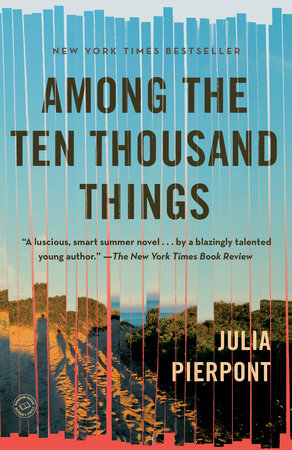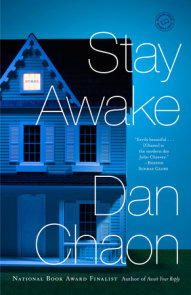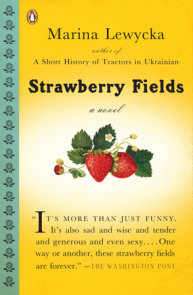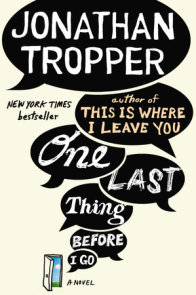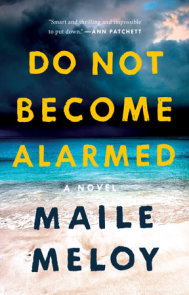READERS GUIDE
A Conversation Between Lena Dunham and Julia PierpontLena Dunham is the author of the number one New York Times bestseller Not That Kind of Girl and the creator of the critically acclaimed HBO series Girls, for which she also serves as executive producer, writer, and director. She has been nominated for eight Emmy awards and has won two Golden Globes, including Best Actress, for her work on Girls. She was the first woman to win the Directors Guild of America award for directorial achievement in a comedy. Dunham has also written and directed two feature-length films (including Tiny Furniture in 2010) and is a frequent contributor to The New Yorker. She lives and works in Brooklyn, New York.
Lena Dunham: Your novel is remarkable for many reasons, but the primary impression it left on me was that you—a relatively young woman—were able to embody so many dueling perspectives with clarity and ease. I am not, of course, implying that women can’t write men or old people can’t write young people or anything reductive like that, but am I implying that? I’m definitely implying that burrowing into the consciousness of a fifty-six-year-old philanderer without judgment or cartoonishness would be damned hard for me. So I guess what I want to know is, (A) How did you approach that process? Did you always know you would include the interior lives of all the members of the Shanley family, or did they surprise you? and, (B) Was one character the closest to your heart, an avatar of sorts?
Julia Pierpont: When I started writing the book, I had zero idea it would be a book, and insisted on saving it as “Novel-length Thing.doc” on my computer for a lot longer than it was cute. Just about the only thing I did know was that I wanted it to be about a family, and I wanted to write it from multiple perspectives. Partly because that’s what many of my own favorite books do, but also because it seemed to be the best way to figure out how and why it’s so hard to go through life without making a terrific mess of things. It’s also just a strange luxury to imagine yourself into other lives, to poke around with another person’s hands.
As far as an avatar, it hasn’t escaped my attention that the book largely manages to avoid the perspective of young women ages twenty-four to twenty-eight, which were all the ages I passed through when writing it. It might just be that the less my characters look like me, the more easily I trust myself to get them right. It takes so much objectivity and so much empathy to write people, and those can be hard things to hang on to when looking at oneself. To that end, Kay was the closest thing I had to an avatar in the book, and some of her chapters were the trickiest to write—and the most painful.
LD: I love knowing that Kay is a sort of Julia mini-me, because she feels like—in a sense is—the writer in the family. Her dirty Seinfeld spec scripts are the funniest and most poignant part of the book for me—expressing so much about her internal state with such a light and odd touch. How did that spectacular concept come to you?
JP: Fan fiction, the act of it, is so interesting, this idea of self-expression through an already-existing template. I don’t think I could ever do it, because writing isn’t cathartic to me—though having written can be [cathartic]. But I have found it soothing to fall asleep to sitcoms, usually Seinfeld or Frasier, and it seemed like it would be sort of wonderfully incongruous to have the cultish devotion associated with fan fiction targeted at a show like Seinfeld. Plus, what Kay observes is confusing! I remember being confused about the ever-widening disparity between TV families and the families I knew.
That Kay is the writer in the family is one of those observations that people have made about the book that never occurred to me while I was writing it. It’s actually alarming that I didn’t know that.
LD: Meanwhile, the moment you mentioned favorite books that employ similar devices, you really whet my curiosity! What books?
JP: Oh man, what books. Virginia Woolf is the master of multiple perspectives, right? E. M. Forster swoops in and out of people’s minds really well, too. And Richard Yates’s The Easter Parade, and Eliot’s Middlemarch, and it happens so much in Anna Karenina that there’s need for a cast list at the beginning. Also, Elizabeth Taylor—an extremely good but extremely sad example is her Mrs. Palfrey at the Claremont.
LD: I think something else this novel does so well that is very hard to achieve is making art within an artwork—whether it’s Kay’s perfectly misguided little stories or Deb’s relationship to dance or Jack’s various creative movements, you manage not to skewer the art world or turn it into a parody. As a kid raised in the art world, I am so sensitive to the “modern art is a trick played on idiots” meme that so often runs through narratives about artists. How did you approach the work within the work?
JP: I think one of the trickiest things for any writer is giving their character a profession. I just don’t know what most people do all day. Making Jack and Deb artists was an opportunity for me to explore different things I’ve felt about my own art—fear of failure, the possibly impossible task of balancing work and “life.” For Deb, I did some homework in the form of watching YouTube videos of dancers breaking in their toe shoes, and reading books—Toni Bentley’s memoir Winter Season is beautifully done. The art world was tougher in a way because it does get so parodied, and I really didn’t want to do that. My mother’s background is in art history and my father is an architect, and they raised me on museums, so I relied on them a lot to let me know what didn’t feel authentic. At the risk of sounding precious about it, I do believe it was easier to create an exhibit by Jack Shanley than it would have been to create my own. As Jack got older and sadder, the character kind of dictated that his art would become smaller and more ephemeral. It actually made me sad, and it can feel terrific to make yourself sad.
LD: It often seems, as our world becomes less laden with taboos—or at least the illusion of broken taboos—that novels are being replaced by the flashiness of highly confessional memoir or reality TV or just plain old TV, where we can watch actual boobs instead of imagining them. I’m not trying to form a grand theory, but the novels that do make it through the clutter and onto everyone’s laps are so often thrillers or experiments in human darkness. Which is why your book, so old-fashioned, in a sense, in its goals—though utterly modern in its emotional approach—was so refreshing to find, to have recommended to me, et cetera. This is a long-winded way of asking, Why fiction, and why fiction now?
JP: That’s such a good, hard question, and I think what makes it especially hard is finding the vocabulary to explain what happens when a book really moves you. The less time we all, as a culture, devote to reading, the more easily we forget what reading can do. A professor I had in graduate school, David Lipsky, called them “yes moments,” when you read a line and recognize some part of yourself in it, something you didn’t know anyone else ever noticed that makes you go, “Yes.” In this way we may come to feel closer to certain writers than to anyone, because we feel that we’re seeing inside their heads and that they’ve somehow already seen inside ours. I also don’t believe it’s exclusive to books; lots of movies and television shows have given me that feeling. I think of it more as a sensitivity that can be applied to any medium. I studied film in college, but when it came to actually making films I was too reluctant to ask for help from other people. It was easier to hole up and make something by myself. I guess I do worry about all our attention spans becoming limited to Vine-length programming, but then people are always worried about something. I should spend less time on my smartphone.
LD: You write about sex in a way that’s both explicit and subtle. As if through the eyes of a child, really. The notable moment when sex isn’t just discussed is the scene where Simon loses his virginity. How do you approach writing about intimacy?
JP: I’d never written a whole lot about sex before this book—I guess I’d never written “a whole lot” about anything before this book. And let me tell you: I loved it. Unintentionally I made things easier for myself by having it be Simon’s first time—of course he was going to notice everything, look at the whole episode through alien eyes. It was also fun to imagine the experience from a male perspective. Simon has an orgasm, which for him, up until now, has been a very solitary event. So his extreme self-consciousness, his terrible fear of embarrassing himself, is now at war with his sexual desire. Sadly, girls don’t usually have to combat this particular inhibition their first time, because more often than not they aren’t having orgasms until later.
The actual dirty parts of the book—the obscene messages between Jack and his mistress, Jordan—were different because they were filtered through Jack’s many years of sexual experience. He was inured to actually noticing things about another person, which made the things he did observe sort of generic and unsexy. Turns out it’s the idiosyncrasies and vulnerabilities that make intimacy truly interesting. Who knew?
LD: You use language in some unorthodox ways—thrillingly so. How do you respond to edits and do you ever feel they cut away at your ability to operate as an individual using language?
JP: Sometimes I’ll write sentences that read like mistakes. I was very lucky to find a team of early readers who appreciated why most of my words were arranged as they were. The notes I got back during editing left the lines mostly alone and focused on the plot. I am extremely receptive to notes on story, because I’m always sort of feeling my way through what happens. Sometimes there are moments when a character could ricochet off in a few directions and I happen to have chosen the wrong one. Or I’ll be shy about dramatics and make the story too quiet—or, knowing that about myself, I’ll overcompensate and make the action too big. It’s helpful to have an editor to keep me on course, to remind me what I want the book to be. All that said, if a sentence comes back three times with the same giant question mark in the margin, I will concede that it’s probably not doing what I want it to.
LD: What did you hope a reader might feel when devouring this book? What is your favorite way to feel toward/from a book?
JP: I’m afraid I’m going to sound very trite if I mention E. M. Forster and what he says in Howards End—“Only connect!”—but look, I’ve done it anyway. The very best moments for me as a reader, the ones that stay with me, are those that teach me something I suspect I already knew. Those moments make you feel as though you’re building something in real time with the person who wrote them, regardless of whether they lived in your lifetime. It’s tempting to try and write to impress, but it’s beside the point and counter to what writing can accomplish. The very best thing I could hope to get out of a reader is a feeling of “Me too” or “I thought I was the only one.”
Questions and Topics for Discussion
1. Among the Ten Thousand Things begins with Kay opening the box of emails from her father’s mistress. Why do you think the author chose to introduce Kay first, and in such a shocking way? Does it set a tone for the rest of the novel?
2. In many ways Simon is too wrapped up in his own social life to be fully present for what is happening to his family. In what ways does this affect him and others?
3. Kay struggles to find her footing with the girls at school and throws herself into her Seinfeld fan fiction, even using it to process the drama unfolding around her. What did you think of the way that she coped?
4. When the affair becomes public, Deb must reassess her marriage. She has to decide whether or not she can face what her husband has done now that her children, family, and friends know. What does this say about the significance of privacy in relationships? What would you do if you were in Deb’s position?
5. When Jack goes home to Arizona he struggles to connect with his mother and step-father. What does this experience illuminate about Jack’s character?
6. Gary seems to be the only one who understands Jack as well as Deb does. What was your impression of the relationship between the three of them? What about Gary’s relationship with Kay and Simon?
7. Many pivotal moments in the novel are seen through Kay’s eyes, through her eleven-year-old lens. What do her observations and reactions teach us about the adult world around her?
8. Which member of the Shanley family did you sympathize with the most? Why?
9. In part two, the author fast forwards in time to show how things turn out for the Shanleys. In what way(s) did this affect your reading experience? Why do you think the author made this decision?
10. In the end, which character do you feel changed the most or was shaped the most by the affair? How does their future self (as shown in part two) reflect that growth?







